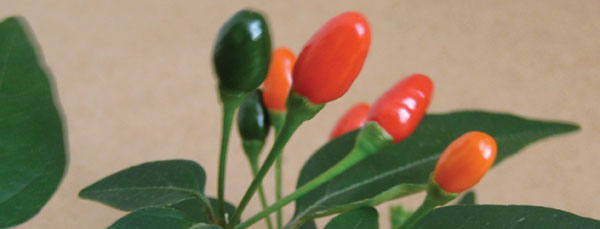Extracts

Muy Caliente: Chili Peppers Heat For Defense
Jay Goodwin
Despite the popularity of spicy cuisine, the hotness in chili peppers has always been something of an evolutionary mystery.
A plant creates fruit in order to entice animals to eat and disperse its seeds, so it doesn’t make sense for that fruit to be painfully hot, said University of Florida zoology professor and evolutionary ecologist Douglas Levey.
But according to new research by Levey and six colleagues from other universities, chilies have a very good reason to make themselves hot. It boils down to protection.
Based on research on wild chili plants in rural Bolivia, the scientists found that the leading cause of seed mortality is a fungus called Fusarium. The fungus invades the fruits through wounds made by insects and destroys the seeds before they can be eaten and dispersed.
Capsaicin, the chemical that makes the peppers hot, drastically slows microbial growth and protects the fruit from Fusarium. And while capsaicin deters local mammals, such as foxes and raccoons, from consuming the chilies, birds don’t have the physiological machinery to detect the spicy chemical and continue to eat the peppers and disperse seeds, Levey said.
The researchers’ findings were published online in August in the Proceedings of the National Academy of Sciences.
Levey and his colleagues were able to arrive at these conclusions because at least three of the approximately 15 species of chilies that grow in the Bolivian wild are polymorphic for pungency, which means that some individuals of those species produce pungent fruit and others produce non-pungent fruit. This provided the researchers with natural experimental conditions under which they could compare Fusarium attack on fruits with and without capsaicin.
Upon studying various chili pepper plants, the researchers observed a clear correlation between high levels of capsaicin and low seed mortality due to fungal growth, Levey said.
And the chemical doesn’t just help the plants that produce it, either. Levey said the consumption of chilies can help protect humans from the dangerous diseases that are so plentiful in tropical climates.
“The use of chili peppers as a spice has spread to nearly every culture within 20 degrees of the equator, and it tends to decline as you move toward the poles,” Levey said.
The capsaicin in chilies, one of the first plants domesticated in the New World, may have been used to protect human food from microbial attack long before refrigeration or artificial preservatives were available, he said.
At higher elevations, where moisture is high and Fusarium fungus is rampant, the scientists found that 100 percent of the plants produced hot chilies. In the drier lowlands, where fungus is less of a problem, only 40 percent of the plants produced fiery fruits.
While all of the plants look identical, telling the difference between hot and non-hot chilies is not difficult, Levey said.
“Just pop one in your mouth,” he said. “You’ll find out pretty quick.”